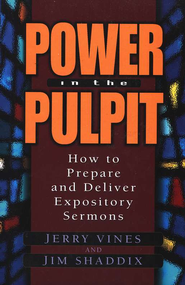
This book review of Jerry Vines and Jim Shaddix‘s Power in the Pulpit was written as part of Pastor Lane’s doctoral course work, and as such, it is written in a more formal, academic tone than the rest of this blog’s posts. Still, we hope the audience will find these academic book reviews useful, which is why we have published them for your reference.
Jerry Vines is retired after pastoring for over 50 years. He was pastor of First Baptist Church, Jacksonville, Florida, for over 23 of those years. In his years as pastor at First Baptist, he baptized 18,177 people. He received his B.A. from Mercer University, a degree from New Orleans Baptist Theological Seminary, and his ThD from Luther Rice Seminary. He served two terms as president of the Southern Baptist Convention. He now leads his own Jerry Vines Ministry, where he continues to lead people to Jesus and help those who know Jesus to grow as Christians. Dr. Vines is a well-known conservative, evangelical pastor, and preacher. There is nothing about his ministry nor his writing that would insinuate otherwise.

Jim Shaddix is currently the senior pastor of Riverside Baptist Church in Denver, Colorado. Prior to serving in his current senior pastor role, he served as the Dean of the Chapel and Associate Professor of Preaching at New Orleans Baptist Theological Seminary. He earned a B.S. in Education from Jacksonville State University in Jacksonville, Alabama, a Master of Divinity, and Doctor of Ministry from Southwestern Baptist Theological Seminary in Ft. Worth, Texas, and a Doctor of Philosophy in preaching from New Orleans Baptist Theological Seminary. He is the co-author of Power in the Pulpit: How to prepare and Deliver Expository Sermons (Moody Press, 1999). He will soon be joining the teaching staff of Southeastern Baptist Theological Seminary. Dr. Shaddix is a conservative, evangelical pastor, and theologian. He has been teaching, training, and influencing pastors for two decades through his teaching and pastoral ministry. His resume of teaching locations and church service demonstrate his leadership at the highest level in this field.
The purpose of Power in the Pulpit is to give practical help, specifically to the man who is faced with the responsibility of preaching weekly. This book is decisively written for the preacher or the one who aspires to become a preacher. It satisfies all necessities as a textbook. But with that said, this book is an excellent read for anyone interested in studying preaching. It is in no way written with any measure of dullness. The author’s have achieved their purpose fully in this book.
Power in the Pulpit makes a unique contribution in a broad field of writing as one of the, if not the, most comprehensive treatments of the complete subject of preaching. The vast range of material covered in this work, as well as the detailed attention from start to finish, is exceptional. As well, this is accomplished without any dryness in reading. There is a life about this book that invigorates the reader to love preaching more deeply and to have a healthier awe for its practice. Another significant contribution is that clarity with which this book is written. Complex ideas are simplified and outlined in such a way that makes them easy to comprehend. A third significant contribution would have to be the way the author establishes the foundation for each part of the book and then moves toward application. The foundation becomes a motivation to excel, not a drudgery that prevents it, through the practices as they are applied. This gives the reader greater comprehension and retaining of information.
A general description of this book would have to be comprehensive. As stated, it begins with establishing foundational issues and builds to healthy, sustainable, and practicable principles in each part. This is definitely a textbook on preaching but not in typical textbook manner. It is informing and engaging, enlightening and encouraging. In comparison to the other textbook type manuals on preaching, I believe this book excels above the others without question.
The structure of the book is defined in three general parts or sections. The first part in “The Preparation for Exposition” and covers a strong definition of preaching, a foundation for preaching, and a focus on a healthy preacher, in the areas of heart, mind, body, and routine. This part of the book could be hard to endure due to content, but the authors have made it exceptionally readable. The sheer amount of material in the content is vast, beginning with biblical word studies that create a framework for philosophical approach to the overall ministry that sets for a rationale for expository preaching. This has to be the most comprehensive treatment of this material I have ever seen in such a concise manner. The authors then makes it very personal as they lead into the preacher’s understanding of what God is doing, as well as what the preacher must do to remain with God in the work. This is strong because too often not enough, if anything, gets said about a preacher’s health, and it shows. There is a great need for emphasis and priority to be given to the development of the preacher.
The second part of the book addresses the handling of the text, or the process of exposition. They do not make light of the work, but they brings clarity to the process. This is the most technical section of the book, for obvious reasons. They begin with analyzing the text through instigation, investigation, interpretation, and implication. This is where they covers the exegesis in great detail. Again, while handling a highly technical aspect they manage to present the information with great clarity. This is not a fast read, but that is due more to the volume of material, not the clarity of writing. In “Unifying the Theme,” they bring the hermeneutic process to bear upon the exegesis, which gives initial structure and meaning to the sermon itself, from the study. They give detailed rationale for each segment and good emphasis on what they calls the “Central Idea of the Text.” Interesting in this chapter is the amount of explanation and reasoning that the authors give for the title. This is more rationale given for a sermon title than I can remember reading in any other book. “Designing the Structure” is the next segment and here they discuss the need for a specific sermon structure. There are a number of benefits, including clarity and retention for the listener, but also for the preacher. They identify and analyze some different methods of structure that have been used, including key word, analytical, or sermonic plot. The structure used will often be determined by exactly what the preacher is trying to accomplish through the sermon, whether mainly instructional or persuasive, and the nature of the material that is being presented. They go on to discuss and explain how the ideas of the material should be matured. I really appreciate the extent of instruction they give here for maturing a sermon. It is too easy to allow a sermon to get assembled with all the ingredients, but never get cooked. This part of the sermon process is so important, and yet so easy to move quickly through. I most appreciate, and have found personal value in, what they refer to as “Incubation,” when through separation, meditation, illumination, and verification great understanding and depth come to the sermon. Finally, in building the sermon, where the manuscript is written, they give excellent instruction for the purpose and value of this.
The third part deals with the presentation of the exposition. As with the other two sections of the book, this part is comprehensive and in-depth. Beginning with “Expressing Your Thoughts,” they challenge the preacher to take serious consideration of his personal presentation style and encourage serious evaluation of the activity of preaching. They give great practical advice about how to use such things as humor, and when not to use it. The primary instrument of the preacher is his voice, and an entire chapter is given to its understanding, improvement, and care. Again here, the extensive treatment of issues is great. They give an amount of information that should not even be tried to take in all in one sitting, but rather creates a reference book to return to for reminders and exercises. “Making the Connection” is the next chapter, and in it they deal with visualizing the sermon for the preacher. To me this is one of the most critical elements in presentation preparation. When the sermon moves to this level with the preacher, it will become so much more than a writing on the paper. It provides a greater personal conviction that is portrayed when the sermon is preached. Finally in “Holding the Ear,” they address vital issues of getting beyond a monotone voice through rate, pace, volume, stress, pitch, phrasing, inflection, and pause. Body language is also addressed here as an important aspect of overall communication.
The writing style of this book is excellent. It is most adept at handling a great volume of information and a highly technical type of information in such a way that is well organized and easily followed. I have not read any other book that comes close to this extent of comprehensive treatment on the subject or that has this excellent a presentation of the material. This book is definitely an advanced level of reading, simply because of the detail that it offers and the technicality that it provides. One who is not regularly engaged or entering the field of preaching would be able to understand, but may not be as interested in this depth of content.
I read the entire book, with the exception of a few of the inset ‘greyed’ areas, and I have not read the Appendix materials yet. Both of which I plan to return to and read.
Of all that this book offers, I am most enthusiastic about returning to it to re-read the sections for further evaluation of my own preaching. I plan to re-evaluate and bring greater definition to my own sermon planning process. This will also be helpful as I return in do more evaluation of my own expository process. I want to work through some of the different methods of sermon structure and try to master more variety and try to avoid monotony. I need to give more time for maturing the idea. I really appreciate their words regarding this and know that the more time I give to this, the more clarity that will come to the sermon. I need to better practice moving from manuscript to preaching outline for final presentation preparation.
More book reviews by Pastor Lane